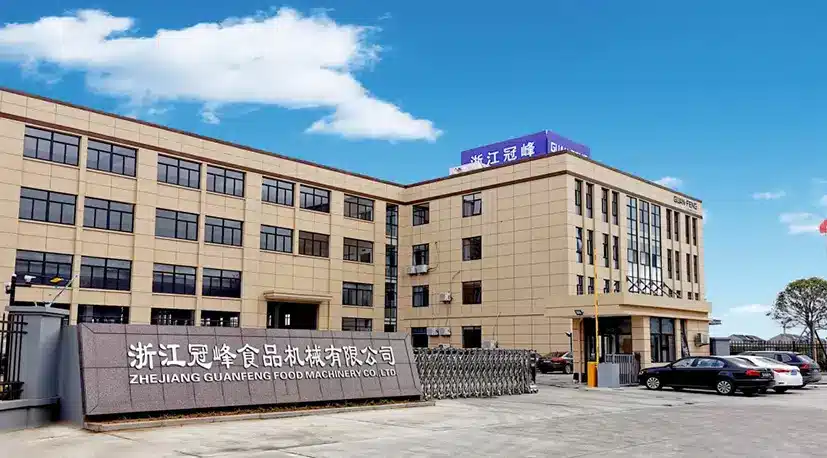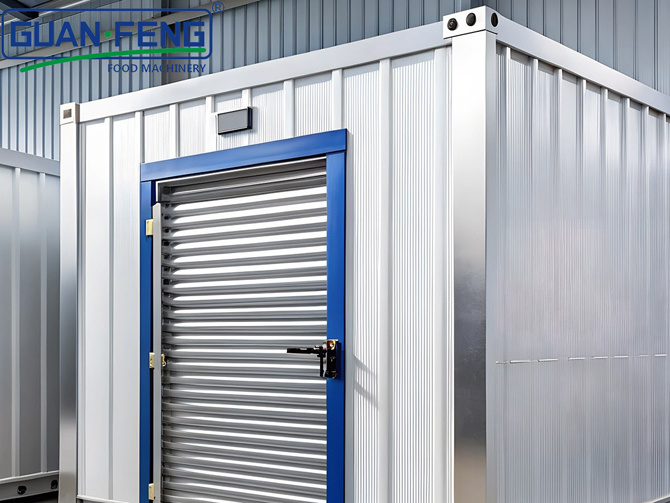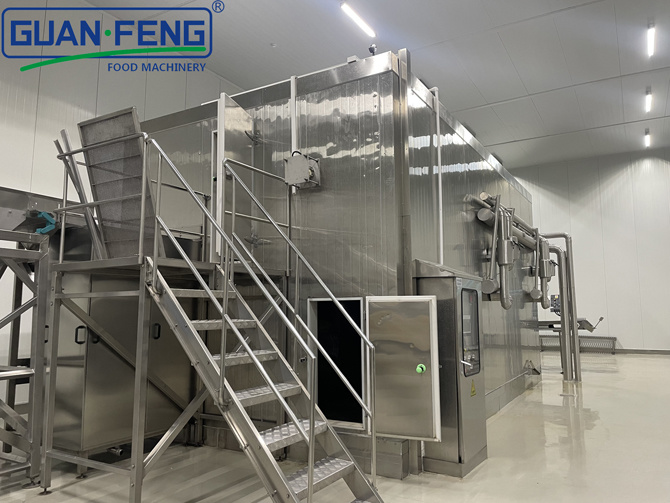BLOG
Focus on hot topics, real-time dynamics
Estimation of Cold Storage Load and Equipment Selection
1. Cold storage load estimation: The most basic conditions required to calculate the cold consumption of a cold storage are the types of goods; Warehouse dimensions (length * width * height); Storage capacity, tons; Purchase quantity, tons/day; Cooling time, hours; Purchasing temperature, ℃; Shipping temperature, ℃.
2. Cold storage storage capacity calculation: Cold storage tonnage calculation formula: G=∑ Vl ρ s η/1000, where G - Cold storage tonnage (t); Vl - nominal volume of the cold storage (m3); η - Capacity utilization coefficient of cold storage; ρ s - density of goods (kg/m3).
3. Cooling load calculation:
Q1- heat flow rate of enclosure structure (W); Q2- Freight heat flow rate (W); Q3- Ventilation heat flow rate (W); Q4- Heat flow rate during motor operation (W); Q5- Operating heat flow rate (W).
4. Warehouse load calculation: Cooling consumption: Warehouse load calculation formula: QE=Q1+PQ2+Q3+Q4+Q5, where QE - Cold room cooling equipment load (W); P - coefficient of heat flow of goods. The load coefficient P for the cooling and freezing rooms should be taken as 1.3, and for other cooling rooms it should be taken as 1. The warehouse load is a selection indicator for evaporators.
5. Mechanical load calculation:
Cooling capacity, mechanical load calculation formula: QM=(n1 ∑ Q1+N2 ∑ Q2+N3 ∑ Q3+N4 ∑ Q4+N5 ∑ Q5) R formula: QM - cold room mechanical load (W); N1~5- Calculation coefficients for various heat flow rates. When there is no significant difference between peak and off peak seasons in production throughout the year, n1 should be taken as 1. Cold processing rooms and other cold rooms should take 1; The refrigeration room for cooling materials should be set at 0.3-0.6; The recommended range for frozen goods in the refrigeration room is 0.5-0.8. R - Compensation coefficient for cooling losses of refrigeration equipment and pipelines, generally taken as 1.07 for direct cooling systems and 1.12 for indirect cooling systems.
Mechanical load is the selection index of the unit
6. Cold storage load estimation: Based on experience, it can be divided into two situations according to the size of the cold storage: small cold storage load estimation (below 400m3); Estimation of cooling load for large cold storage facilities (over 400m3).
Estimation of cooling load for small cold storage (below 400m3): storage temperature above 0 ℃, evaporation temperature -10 ℃, 50-120W/m3; Storage temperature -18 ℃, evaporation temperature -28 ℃, 50-110W/m3; Storage temperature -25 ℃, evaporation temperature -33 ℃, 50-100W/m3; The storage temperature is -35 ℃, the evaporation temperature is -43 ℃, 1 ton occupies 7m2, and the cooling consumption is 5KW/ton * day; The smaller the cold storage, the greater the cooling consumption per unit volume.
Logistics warehouse: Purchase volume: 10%/day. Cooling time: 18-24 hours. Purchasing temperature: medium temperature warehouse 25 ℃/low temperature warehouse -8 ℃. Shipping temperature: Medium temperature warehouse 0 ℃/Low temperature warehouse -18 ℃. The smaller the cold storage, the greater the cooling consumption per unit volume.
Estimation of cooling load for large cold storage facilities (over 400m3): 1. Storage temperature of 0-4 ℃, evaporation temperature of -10 ℃; 2. Storage temperature -18 ℃, evaporation temperature -28 ℃. 1. Storage temperature 0-4 ℃, evaporation temperature -10 ℃
Default parameters: Goods name: Fruits and vegetables; Storage capacity (ton): 0.3 * 0.55 * storage capacity m3; Purchase volume 8%; Cooling time of 24 hours; Purchasing temperature: 25 ℃; Shipping temperature: 2 ℃. When set to default parameters, the mechanical load of the medium temperature warehouse is between 25-40W/m3; Typical configuration: 4 cold storage rooms; 90HP parallel unit with medium temperature storage 1000 ㎡ * 4.5m high.
2. The storage temperature is -18 ℃, and the evaporation temperature is -28 ℃. The default parameters are: cargo name: frozen meat; Storage capacity (ton): 0.4 * 0.55 * storage capacity m3; Purchasing volume, 5%; Cooling time of 24 hours; Purchasing temperature: -8 ℃; Shipping temperature: -18 ℃.
When the default parameters are set, the mechanical load of the low-temperature warehouse is 18-35W/m3; Typical configuration: 4 cold storage rooms; 90HP low-temperature parallel unit with low-temperature storage 1000 ㎡ * 4.5m high.
When default parameters are set, the mechanical load of the low-temperature warehouse is 18-35W/m3; Typical configuration: 4 cold storage screw machines+ECO; 75HP low-temperature parallel unit with low-temperature storage 1000 ㎡ * 4.5m high.
Storage temperature -18 ℃, storage temperature 0 ℃;
Typical configuration: 4 cold storage rooms; 90HP low-temperature parallel unit with low-temperature storage 1000 ㎡ * 4.5m high; Low temperature compressor with a cooling capacity of 1KW/HP; The cooling capacity of the medium temperature compressor is 2KW/HP.
7. Precautions for selecting cold storage equipment: Condenser: Evaporative cooling in case of large fluctuations in operating conditions; Air cooler: Low temperature air coolers are used in high-temperature warehouses for heat exchange and expansion valves; Compressor: Low temperature compressor for high temperature storage; Hot air defrosting: quick freezing warehouse; Water flushing frost: water temperature; Floor antifreeze: ventilation, exhaust heating ethylene glycol.
8. Design considerations for non-standard cold storage: Water: three-stage water cooling - water freezing - ice cooling; Respiratory heat: mushroom storage; Fresh air exchange: operating room, grape storage room; Cold room humidity: seed bank; Fast cooling of fruits and vegetables: procurement and timing; Chestnut refrigeration: sprinkle water; Noodles and vermicelli cold storage: four sections; Water freezing: mineral water, skating rink; Cross frozen. Water: three-stage water cooling - water freezing - ice cooling; Water cooling: 4.187 KJ/Kg * ℃; Water freezes: 334.94KJ/Kg; Ice cooling: 2.093 KJ/Kg * ℃.
Noodles and vermicelli cold storage: four sections, 1 ton of dry powder out of 3 tons of wet powder; **Section: 35 ℃ -2 ℃, 2h; Section: 2 ℃ -4 ℃, 2h; Section: -4 ℃ -10 ℃, 6h; Section: -10 ℃ -14 ℃, 2h; Wet powder 1 ton/h, 120HP piston parallel unit, top exhaust pipe+air cooler.
9. Unit selection: 1. Single machine, single warehouse; 2. One machine with multiple warehouses; 3. Combined with multiple cold storage units.
1. Single machine single warehouse: Unit cooling capacity=1.1 x cold storage consumption; The total cooling capacity of the system should consider a surplus coefficient of 1.1-1.15.
2. One machine with multiple storage facilities: Unit cooling capacity=1.07 x sum of cold storage consumption; The total cooling capacity of the system should take into account a pipeline loss of 7%.
3. Parallel unit with multiple cold storage rooms: Unit cooling capacity=P x sum of cold storage consumption;
Hot Tags:
PREVIOUS:
Contact Us
E-mail:
sales@syguanfeng.com
Tel:
+86 15088506234
Address:
South Industrial Park of Dongguan, Shangyu District, Shaoxing City,Zhejiang Province,China.
GUANFENG, your customization experts!
GUANFENG FOOD MACHINERY - leading supplier of integrated food processing solutions
Copyright© 2024 ZHEJIANG GUANFENG FOOD MACHINERY CO.,LTD.










